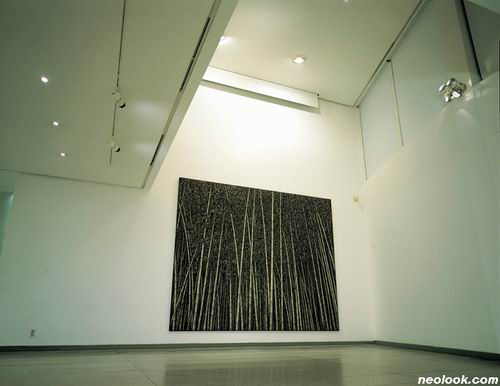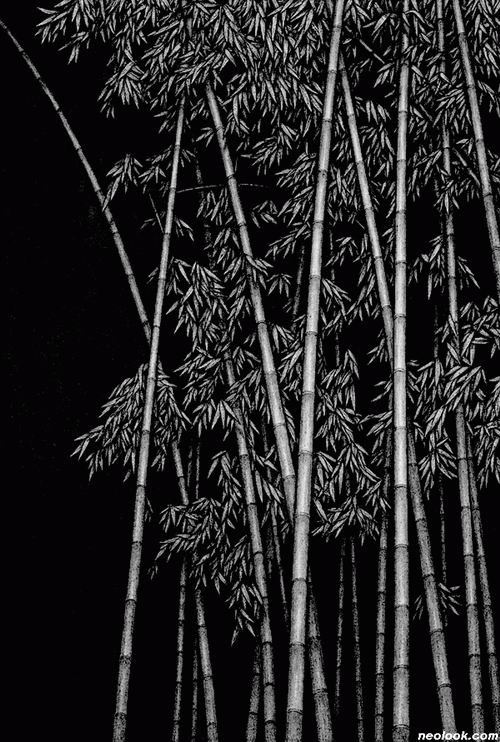- ● homepage
- ● archives
- ● restoration
- ● books
- ● big banners
- ● post board
- ■ neo's search
- ■ about us
- ■ 게재방법 안내
- 개인정보처리방침

- [email protected]
- Tel. 02_335_7922
- Fax. 02_335_7929
- 10:00am~04:30pm
- 월요일~금요일
- 3/3(월) 대체공휴일

바람채집
이재삼展 / LEEJAESAM / 李在三 / painting 2007_0530 ▶ 2007_0611
● 위 이미지를 클릭하면 네오룩 아카이브 Vol.20000106a | 이재삼展으로 갑니다.
초대일시_2007_0530_수요일_05:00pm
갤러리 아트싸이드 서울 종로구 관훈동 170번지 Tel. 02_725_1020 www.artside.org
저 너머에는 무엇이 있을까? ● 밤하늘에 달을 그려보자. 어떻게 그리는 것이 좋을까? 선으로 달 모양을 그려놓고 먹물로 달빛을 칠하려니 어쩐지 조금 싱겁다. 차라리 구름을 드리워 붓이 닿지 않은 부분으로 달빛이 발하도록 하는 것(烘雲拓月)은 어떨까. 굳이 말하지 않아도 전달되는 것이 있고, 그리지 않아도 보이는 것이 있으니 그윽한 맛이 있다. 이러한 멋을 우리는 이재삼의 작품에서도 어렵지 않게 느껴볼 수 있다. 그는 자신을 스스로 '예술장인(藝術匠人)'이라고 부른다. 장인이라고 하기에는 예술가적 성향이 묻어나질 않고, 전업화가라고 하기엔 장인적 기운이 베어나질 않았기 때문일 것이다. 우리가 그에게서 주목할 것은 작가를 심미적 세계로 인도하는 '숲'이라는 소재와 그를 장인의 길로 들어서게 했던 '목탄'이란 재료이다.

- 이재삼_저 너머(beyond there)_캔버스에 목탄_291×364cm_갤러리 아트싸이드_2006

- 이재삼_저 너머(beyond there)_캔버스에 목탄_130×325cm_2007
목탄(Charcoal)은 정밀성과 내구성이 부족하여 회화보다는 소묘 또는 밑그림과 같은 기초 드로잉에 쓰이는 재료였다. 하지만 그는 십여 년 동안 끊임없는 실험을 거듭하여 목탄화를 회화로 승격시킨 장본인이다. 과연 무엇이 그를 목탄에 전념하도록 했을까? 작가는 말한다. 목탄은 검은 '색'이 아닌 검은 '공간'이라고. 아크릴이나 유화가 빛을 반사함으로써 색을 발하는데, 목탄은 빛을 흡수함으로써 블랙홀과 같은 검은 공간을 만들어낸다. 무광의 맛. 모든 것을 품어낼 것만 같은 무한한 공간 속에서 그는 모성(母性)을 연상했을지 모를 일이다. 또한 어떤 의미에서 그에게 목탄은 제법 신성한 도구이다. 본래 목탄이란 나무를 연소시켜 얻은 것이지만, 다시금 목탄으로 나무를 재현하니 숲의 영혼을 환생시키는 것이 아니겠는가.

- 이재삼_저 너머(beyond there)_캔버스에 목탄_194×130cm_2007
간혹 그를 대나무를 그리는 작가로 오인하는 사람들이 있다. 하지만 그는 말한다. 이번 전시가 대나무를 보여주는 마지막 전시가 될 것이라고. 실제로 그는 이번 전시를 통해서 처음으로 매화를 선보였다. 그리고 앞으로는 소나무도 보여줄 생각이라고 한다. 소나무, 대나무, 매화는 한겨울 세찬 바람과 혹독한 추위 속에서도 본연의 색을 잃지 않는다는 세 친구가 아니던가. 비록 그가 세한삼우(歲寒三友)라는 동양화 소재를 빌어 왔지만 곧바로 '선비정신'을 연상한다면 조금은 성급한 감이 있다. 그보다 먼저, 작품의 제목을 살펴보자. 「저 너머(beyond there)」. 모든 작품의 제목이 똑같다. 사실 그의 작업을 이해하기 위해서 빼놓을 수 없는 것이 바로 이 제목이다. 십여 년이 넘도록 모든 작품의 제목을 하나같이「저 너머」라고 붙이는 작가의 의도가 궁금하지 않을 수 없다. 그러자 그는 말한다. 자신이 주목하는 것은 사물 그 자체가 아니라 사물과 사물 사이, 그 경계가 만들어내는 빈 공간이라고.

- 이재삼_저 너머(beyond there)_캔버스에 목탄_194×130cm_2007
손가락으로 달을 가리키는데 달은 보지 않고 손가락 끝만 본다면 안타까운 일이다. 달을 봤으면 손가락은 잊어야 하는 법. 결국 대나무 숲을 통해서 그가 보여주고 싶은 것은 대나무가 아니라, 대숲 사이로 보일 듯 말 듯한 검은 공간이다. 그 검은 여백 속에 그가 보여주고 싶은 혹은 그가 보고 싶은 비경(秘境)이 숨어있는 것이다. 대나무 숲. 그 사이로 검은 바람이 불어온다. 마치 숲의 영혼처럼. 저기 바람이 머무는 대나무 숲 사이, 저 너머에는 무엇이 있을까? ■ 권혁주

- 이재삼_저 너머(beyond there)_캔버스에 목탄_194×130cm_2007
What is beyond there? ● Let's draw the moon on the night sky. How should I draw? It looks little dull once I drew the line of the moon and painted with inky water. How about draw the cloud over top of the moon and let the moon shining through it where brush can not reach. You don't have to say anything to express what is in it and you don't have to even draw to show and that is what we call grace of this drawing. We have no hard time finding this grace from the work of artist Lee Jae sam. People recall him as craftsman of art. He doesn't have enough craftsmanship to be called professional artist, and he doesn't show much bent for an artist to be called craftsman. But what we need to focus about him is his charcoal which leads him to the path of craftsman and his work "forest" entered him into the artist of the world. ● Charcoal only used in basic drawing like sketch or dessein rather than used in actual painting due to its lack of accuracy and durability. However he is the one who made charcoal painting up to the level of real painting through ten years of endless experiments. Now what made him so devoted over charcoal? He says that charcoal is not black "color "it is black "space". When acrylic and oil painting show the color by reflecting light, charcoal makes black space by absorbing light like the black hole. Charcoal's light without the light, he was maybe thinking about motherhood in infinite space where it bears anything in. Plus charcoal is his divine tool in some way. Because reappearance of the forest with charcoal is like reviving the spirit of the forest for charcoal originally comes from burned wood. ● Sometimes people had mistaken him for bamboo artist. But he is telling them this would be his last exhibit of bamboo paintings. In fact he exhibits of a Japanese apricot tree painting for the first time. And now he is planning to exhibit the pine tree in the future. After all these pine tree, a Japanese apricot tree, and bamboo are the three creatures standing in the harsh cold and blowing wind in winter without losing their own color. ● It would be little quick to judge his painting as Oriental painting or the Four Gracious Plants just because of these three traditional subjects he is using. We have to focus on title "beyond there" of his work to understand the artist. It is hard not to ask the artist why he named all of his works as "beyond there" for the last 10 years. Then he answered what he focused on the paintings are not the subject itself, it is rather about the empty space between the subjects he usually puts his mind on. ● It would be a shame if you can only see the finger but not the moon when you point your finger at it. When you see the moon you got to let the finger go. It means he wanted to show black space between the bamboos not the bamboo itself. The mystery land, he wanted to see and wanted to showed, is in between those black, empty bamboos. Winds blowing between Bamboo forests just like spirit of forest. What is beyond out there among bamboo forest where wind blows? ■ Kwon, Hyuck-Ju
Vol.20070529f | 이재삼展 / LEEJAESAM / 李在三 / painting

